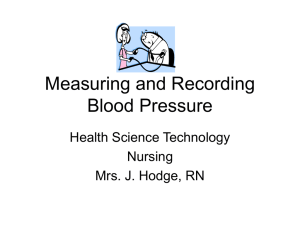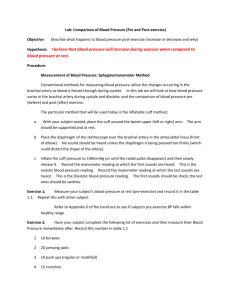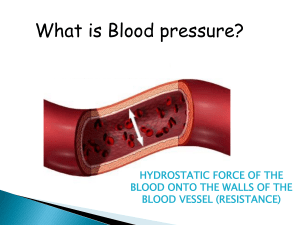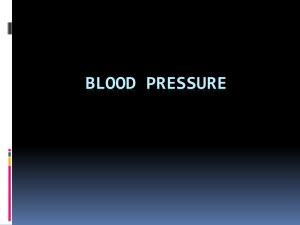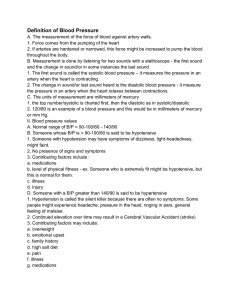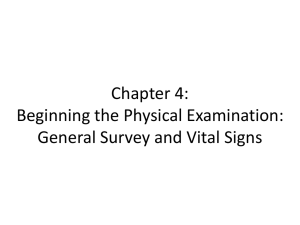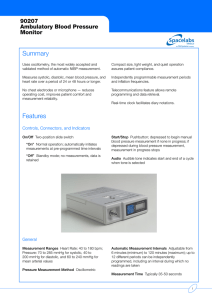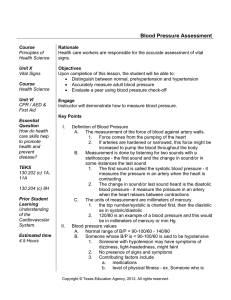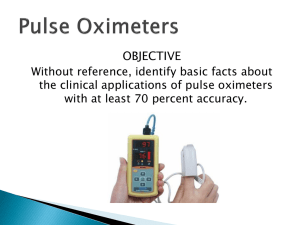Measuring Blood Pressure: Procedure & Factors | Health Science
advertisement
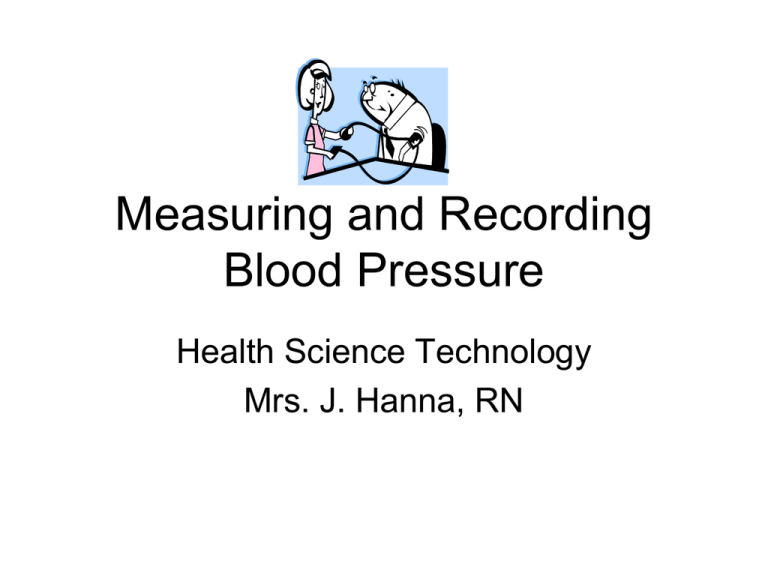
Measuring and Recording Blood Pressure Health Science Technology Mrs. J. Hanna, RN Blood Pressure-BP • Measurement of pressure that the blood exerts on the artery walls during the various stages of heart activity. • Measured in mmHg on instrument called a sphygmomanometer. (blood pressure cuff) Two types of BP • Systolic-top#-first beat heard • Diastolic-bottom #-last beats heard Systolic Pressure • Systolic pressure occurs in artery walls when the L ventricle of the heart is contracting and pushing blood into the arteries. • Normal systolic reading is 120 mmHg • Normal range is 100-140 mmHg Diastolic Blood Pressure • Diastolic pressure-constant pressure in artery walls when L ventricle of heart is at rest or between contractions. • Volume of blood in arteries has decreased. • Normal reading: 80mm/Hg • Normal range: 60-90 mm/Hg Pulse Pressure • Difference between systolic and diastolic pressure • Normal range in adults is 30 to 50 mm/Hg. • Example: Systolic pressure is 120 mm/Hg and diastolic pressure is 80 mm/Hg, the pulse pressure is 40 mm/Hg. (120-80=40) HYPERTENSION • High blood pressure • When pressures are greater than 140 mm/Hg systolic and 90 mm/Hg diastolic Common Causes: stress, anxiety, kidney disease, aging, high-salt intake, thyroid deficiency, and vascular conditions. HYPOTENSION • Low blood pressure when pressures are less than 100 mm/Hg systolic and 60 mm/Hg diastolic. Common Causes: heart failure, hemorrhage, dehydration, depression, severe burns. Orthostatic Hypotension • Postural hypotension-occurs when there is a sudden drop in both systolic and diastolic pressure. • This occurs when the individual moves from a lying to a sitting or standing position. • Caused by inability of blood vessels to compensate quickly to the change in position. Various Factors Influences BP Readings • • • • Force of heartbeat Resistance of the arterial system Elasticity of the arteries Volume of the blood in arteries Various Factors Causing Increased BP 1. excitement, anxiety, nervous tension 2. Exercise and eating 3. smoking Various Factors Causing Decreased BP • • • • • Rest or sleep Depressant drugs Shock Excessive loss of blood Fasting Factor that may cause changes • Lying down • Sitting position • Standing position Recording BP • • • • Record as a fraction. Systolic is the top number Diastolic is the bottom number 120/80 Two main types of sphygmomanometers • Mercury sphygmomanometer-has long column of mercury • Each mark represents 2 mmHg. • Aneroid has round gauge • Cuff deflated=zero for accuracy • *Electronic types used in healthcare facilities. Recommendations • AHA-American Heart Assn. recommends pt. sit quietly for @ least 5 min. before taking BP. • AHA recommends that two readings be taken, averaged, with a minimum wait of 30 seconds between readings. • Pt. seated or lying comfortably with forearm supported on flat surface. Procedure • Cuff appropriate size for pt. • Arm free of restrictive clothing • Deflated cuff should be placed on arm with center of cuff directly over the brachial artery. • Lower edge of cuff should be 1-1 ½ inches above the bend of the elbow. Rest of the procedure • Final point-accuracy in placing stethoscope bell or diaphragm directly over the brachial artery at the antecubital area (bend in the elbow). • Hold securely but with slight pressure. • NEVER DISCUSS ANY READING OR VS READING WITH A PT/RESIDENT! Do not use • Arm with IV • Arm with paralysis Reflection • Your resident’s blood pressure is 186/110. • Discuss with a partner what this means and what your next step would be. • Explore some of the questions you might want to ask the resident if he were at home or at a community event.

